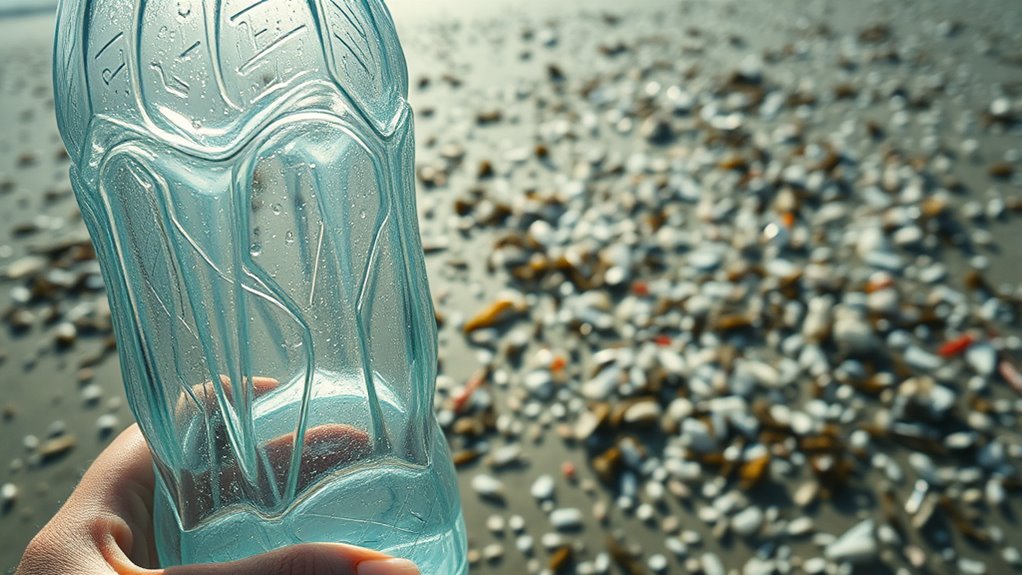plastics can release chemicals like BPA and phthalates into your food, water, and air, especially when heated or damaged. These substances mimic hormones and can disrupt your body’s natural functions, leading to reproductive issues, hormonal imbalances, and increased cancer risks. Microplastics also carry these chemicals into your system through the environment. By understanding these risks, you can take steps to reduce exposure—if you stay tuned, you’ll discover practical ways to protect yourself.
Key Takeaways
- Chemicals like BPA and phthalates leach from plastics into food, water, and air, posing health risks.
- Long-term exposure to plastic chemicals can disrupt hormonal balance and increase cancer risk.
- Heating plastics accelerates chemical migration, raising the likelihood of consuming harmful additives.
- Microplastics carry leached chemicals into the environment and food chain, affecting human health.
- Using safer, non-plastic alternatives reduces exposure to hazardous substances linked to health issues.

Plastics have become an integral part of daily life, but their impact on human health is a growing concern. One of the key issues is plastic leaching, where chemicals from plastic materials seep into food, beverages, or even the air we breathe. When plastics are heated, damaged, or come into contact with certain substances, they can release chemicals like bisphenol A (BPA), phthalates, and other additives. These compounds are not bound tightly within the plastic matrix and can migrate into our bodies over time. Once inside, they can interfere with normal biological processes, raising alarms about long-term health risks.
Plastics can release harmful chemicals like BPA and phthalates, risking long-term health when they leach into food and air.
A major concern linked to plastic leaching is endocrine disruption. Endocrine disruptors are chemicals that interfere with the body’s hormonal systems, which regulate everything from growth and metabolism to reproductive health. When these chemicals enter your body, they can mimic or block natural hormones, leading to a cascade of health issues. For example, BPA, a common component in many plastics, is known to mimic estrogen. This mimicry can disrupt reproductive functions, impair fertility, and even increase the risk of hormone-related cancers. Similarly, phthalates used to soften plastics are linked to hormonal imbalances, developmental problems in children, and metabolic disorders.
You might not realize how pervasive plastic leaching is. Everyday items like water bottles, food containers, and packaging materials are potential sources. Warm liquids or foods stored in plastic containers can accelerate chemical migration. Even plastic wrap or packaging that appears clean can contain residues that leach once heated or exposed to sunlight. The problem extends to the environment as well, where plastics break down into microplastics, carrying these harmful chemicals into water sources and, eventually, into the food chain. As a result, you could be exposed to these chemicals not just through direct contact but also indirectly through contaminated food and water.
Understanding the risks associated with plastic leaching and endocrine disruption is vital for making informed choices. Reducing your exposure involves avoiding plastics labeled with recycling codes 3 and 7, which often contain BPA and phthalates. Opt for glass, stainless steel, or other non-plastic containers for storing food and beverages, especially when heating. Be cautious with plastic wrap and consider alternatives like beeswax wraps or silicone covers. While it’s impossible to eliminate all exposure, these steps can considerably lower your risk. Awareness of how plastics can leach chemicals and disrupt hormones empowers you to protect your health and advocate for safer alternatives. Additionally, choosing products made from BPA-free materials can further reduce your exposure to harmful chemicals.
Frequently Asked Questions
Are All Plastics Equally Harmful to Human Health?
Not all plastics are equally harmful to your health. Some plastics, like those involved in plastic recycling, release harmful chemicals, especially when heated. Microplastic absorption is a concern as tiny particles can enter your body through contaminated food or water. You should be cautious with different plastics, knowing that certain types pose greater risks due to chemical leaching and microplastic exposure, which may affect your health over time.
How Do Plastics Enter the Human Body?
Plastics enter your body mainly through plastic ingestion and dermal absorption. You might swallow tiny plastic particles present in food, water, or dust, which then transfer into your digestive system. Additionally, plastics can seep through your skin when exposed to contaminated substances or environments, allowing chemicals to be absorbed dermally. These pathways make it essential to be aware of your exposure sources and reduce contact with plastics whenever possible.
What Are the Long-Term Health Effects of Plastic Exposure?
You might wonder about the long-term health effects of plastic exposure. Over time, microplastic accumulation in your body can lead to endocrine disruption, which affects hormone balance and may cause reproductive issues, metabolic problems, or even increase cancer risks. Continuous exposure can weaken your immune system and trigger inflammation. Staying informed about these risks helps you make better choices to reduce your plastic contact and protect your health.
Can Plastic Additives Affect Children More Severely?
Imagine tiny whispers of chemicals slipping from plastics, quietly touching your child’s developing body. Plastic leaching poses a greater concern for children, as their vulnerability makes them more susceptible to these subtle influences. Their growing systems can absorb and react more intensely to harmful additives, potentially affecting their health long-term. You should stay cautious, minimizing exposure, and choosing safer alternatives to protect your child’s delicate development from unseen risks.
Are There Safe Alternatives to Traditional Plastics?
You’re looking for safe alternatives to traditional plastics, and biodegradable plastics or plant-based alternatives could be your answer. These options break down more quickly and often use renewable resources, reducing environmental impact and potential health risks. Choosing biodegradable or plant-based plastics helps you avoid harmful additives found in conventional plastics, making them safer for both humans and the planet. Always check product labels to verify they’re genuinely eco-friendly and safe.
Conclusion
As you go about your daily life, it’s no coincidence that plastics are everywhere — from your water bottle to your food packaging. While they seem harmless, the evidence shows they can subtly impact your health over time. Remember, small choices add up. By staying aware and making mindful decisions, you can reduce your exposure. Sometimes, the tiniest change can make a big difference, reminding you that your health truly depends on what you choose to ignore or address.










